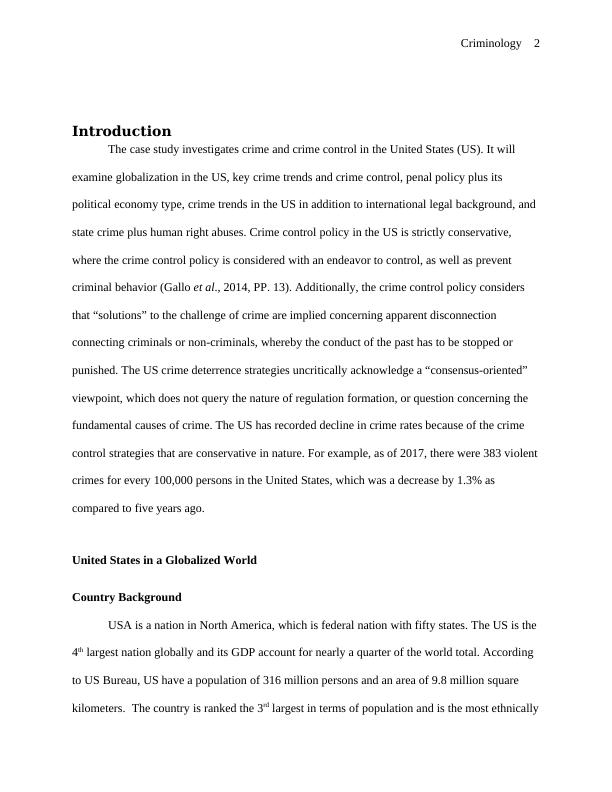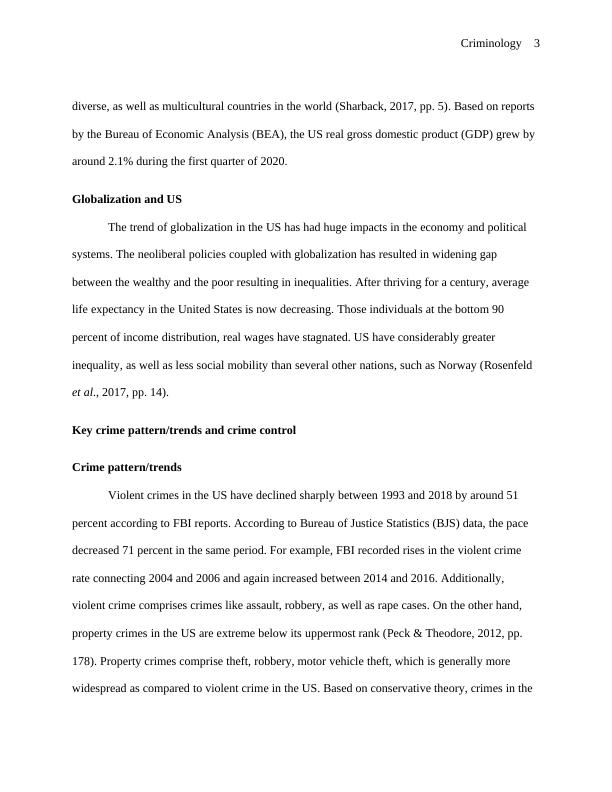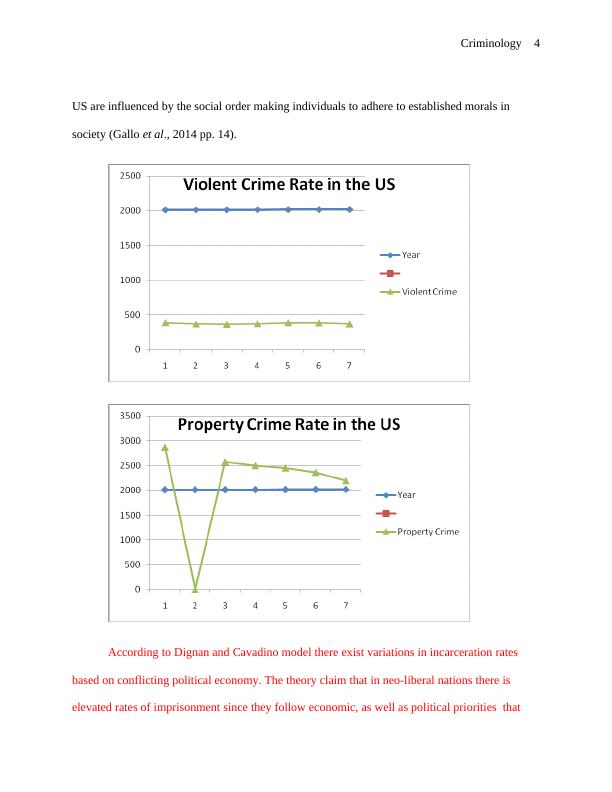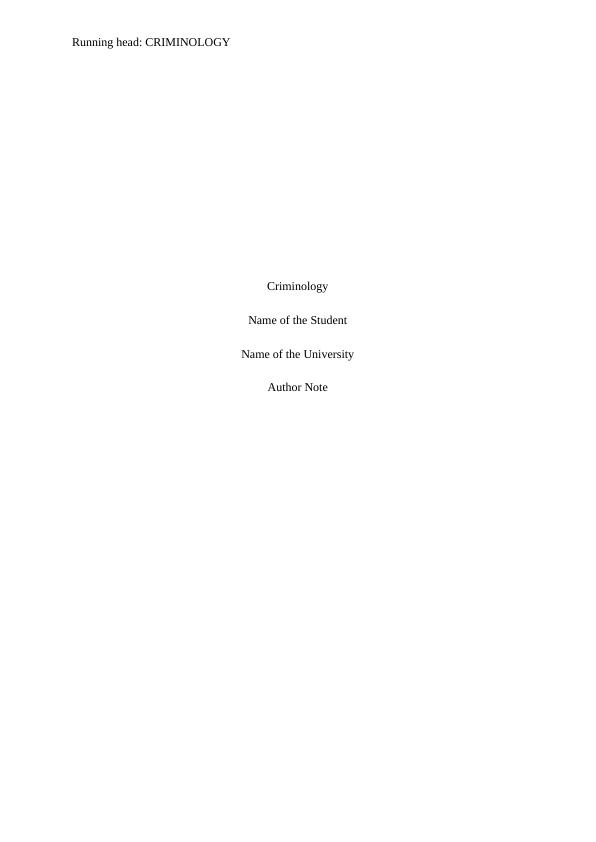Case Study on Criminology 2022
Added on 2022-09-25
15 Pages3918 Words21 Views
Criminology 1
CRIMINOLOGY
By (Name)
Course
Professor
University
City and State
The Date
CRIMINOLOGY
By (Name)
Course
Professor
University
City and State
The Date

Criminology 2
Introduction
The case study investigates crime and crime control in the United States (US). It will
examine globalization in the US, key crime trends and crime control, penal policy plus its
political economy type, crime trends in the US in addition to international legal background, and
state crime plus human right abuses. Crime control policy in the US is strictly conservative,
where the crime control policy is considered with an endeavor to control, as well as prevent
criminal behavior (Gallo et al., 2014, PP. 13). Additionally, the crime control policy considers
that “solutions” to the challenge of crime are implied concerning apparent disconnection
connecting criminals or non-criminals, whereby the conduct of the past has to be stopped or
punished. The US crime deterrence strategies uncritically acknowledge a “consensus-oriented”
viewpoint, which does not query the nature of regulation formation, or question concerning the
fundamental causes of crime. The US has recorded decline in crime rates because of the crime
control strategies that are conservative in nature. For example, as of 2017, there were 383 violent
crimes for every 100,000 persons in the United States, which was a decrease by 1.3% as
compared to five years ago.
United States in a Globalized World
Country Background
USA is a nation in North America, which is federal nation with fifty states. The US is the
4th largest nation globally and its GDP account for nearly a quarter of the world total. According
to US Bureau, US have a population of 316 million persons and an area of 9.8 million square
kilometers. The country is ranked the 3rd largest in terms of population and is the most ethnically
Introduction
The case study investigates crime and crime control in the United States (US). It will
examine globalization in the US, key crime trends and crime control, penal policy plus its
political economy type, crime trends in the US in addition to international legal background, and
state crime plus human right abuses. Crime control policy in the US is strictly conservative,
where the crime control policy is considered with an endeavor to control, as well as prevent
criminal behavior (Gallo et al., 2014, PP. 13). Additionally, the crime control policy considers
that “solutions” to the challenge of crime are implied concerning apparent disconnection
connecting criminals or non-criminals, whereby the conduct of the past has to be stopped or
punished. The US crime deterrence strategies uncritically acknowledge a “consensus-oriented”
viewpoint, which does not query the nature of regulation formation, or question concerning the
fundamental causes of crime. The US has recorded decline in crime rates because of the crime
control strategies that are conservative in nature. For example, as of 2017, there were 383 violent
crimes for every 100,000 persons in the United States, which was a decrease by 1.3% as
compared to five years ago.
United States in a Globalized World
Country Background
USA is a nation in North America, which is federal nation with fifty states. The US is the
4th largest nation globally and its GDP account for nearly a quarter of the world total. According
to US Bureau, US have a population of 316 million persons and an area of 9.8 million square
kilometers. The country is ranked the 3rd largest in terms of population and is the most ethnically

Criminology 3
diverse, as well as multicultural countries in the world (Sharback, 2017, pp. 5). Based on reports
by the Bureau of Economic Analysis (BEA), the US real gross domestic product (GDP) grew by
around 2.1% during the first quarter of 2020.
Globalization and US
The trend of globalization in the US has had huge impacts in the economy and political
systems. The neoliberal policies coupled with globalization has resulted in widening gap
between the wealthy and the poor resulting in inequalities. After thriving for a century, average
life expectancy in the United States is now decreasing. Those individuals at the bottom 90
percent of income distribution, real wages have stagnated. US have considerably greater
inequality, as well as less social mobility than several other nations, such as Norway (Rosenfeld
et al., 2017, pp. 14).
Key crime pattern/trends and crime control
Crime pattern/trends
Violent crimes in the US have declined sharply between 1993 and 2018 by around 51
percent according to FBI reports. According to Bureau of Justice Statistics (BJS) data, the pace
decreased 71 percent in the same period. For example, FBI recorded rises in the violent crime
rate connecting 2004 and 2006 and again increased between 2014 and 2016. Additionally,
violent crime comprises crimes like assault, robbery, as well as rape cases. On the other hand,
property crimes in the US are extreme below its uppermost rank (Peck & Theodore, 2012, pp.
178). Property crimes comprise theft, robbery, motor vehicle theft, which is generally more
widespread as compared to violent crime in the US. Based on conservative theory, crimes in the
diverse, as well as multicultural countries in the world (Sharback, 2017, pp. 5). Based on reports
by the Bureau of Economic Analysis (BEA), the US real gross domestic product (GDP) grew by
around 2.1% during the first quarter of 2020.
Globalization and US
The trend of globalization in the US has had huge impacts in the economy and political
systems. The neoliberal policies coupled with globalization has resulted in widening gap
between the wealthy and the poor resulting in inequalities. After thriving for a century, average
life expectancy in the United States is now decreasing. Those individuals at the bottom 90
percent of income distribution, real wages have stagnated. US have considerably greater
inequality, as well as less social mobility than several other nations, such as Norway (Rosenfeld
et al., 2017, pp. 14).
Key crime pattern/trends and crime control
Crime pattern/trends
Violent crimes in the US have declined sharply between 1993 and 2018 by around 51
percent according to FBI reports. According to Bureau of Justice Statistics (BJS) data, the pace
decreased 71 percent in the same period. For example, FBI recorded rises in the violent crime
rate connecting 2004 and 2006 and again increased between 2014 and 2016. Additionally,
violent crime comprises crimes like assault, robbery, as well as rape cases. On the other hand,
property crimes in the US are extreme below its uppermost rank (Peck & Theodore, 2012, pp.
178). Property crimes comprise theft, robbery, motor vehicle theft, which is generally more
widespread as compared to violent crime in the US. Based on conservative theory, crimes in the

Criminology 4
US are influenced by the social order making individuals to adhere to established morals in
society (Gallo et al., 2014 pp. 14).
According to Dignan and Cavadino model there exist variations in incarceration rates
based on conflicting political economy. The theory claim that in neo-liberal nations there is
elevated rates of imprisonment since they follow economic, as well as political priorities that
US are influenced by the social order making individuals to adhere to established morals in
society (Gallo et al., 2014 pp. 14).
According to Dignan and Cavadino model there exist variations in incarceration rates
based on conflicting political economy. The theory claim that in neo-liberal nations there is
elevated rates of imprisonment since they follow economic, as well as political priorities that

Running head: CRIMINOLOGY
Criminology
Name of the Student
Name of the University
Author Note
Criminology
Name of the Student
Name of the University
Author Note

1CRIMINOLOGY
Table of Contents
Introduction................................................................................................................................2
Legal definition of Crime and Murder in Canada......................................................................2
Crime statistics by UCR.............................................................................................................3
Victimization by GSS................................................................................................................4
Dissociative Identity Disorder theory explains Murder.............................................................5
National Crime Prevention Strategy..........................................................................................5
Conclusion..................................................................................................................................6
References:.................................................................................................................................7
Table of Contents
Introduction................................................................................................................................2
Legal definition of Crime and Murder in Canada......................................................................2
Crime statistics by UCR.............................................................................................................3
Victimization by GSS................................................................................................................4
Dissociative Identity Disorder theory explains Murder.............................................................5
National Crime Prevention Strategy..........................................................................................5
Conclusion..................................................................................................................................6
References:.................................................................................................................................7

2CRIMINOLOGY
Introduction
In modern society, crime can be referred to as an act or an omission to do an act
which is prohibited under law and contravention of such law would attract punishments and
sanctions. Broadly, the concept of crime is viewed as equivalent to immoral, antisocial and
sinful approach of people which contravene the usual course of life in a civilized society. An
act is marked as a crime when the laws guiding it are violated. The idea of crime differs from
one can culture to the other except for certain severe wrongful actions like treason and incest
which are condemned in all civilized societies. Law in general reflects the interest of the
majority and prohibited such act which would hurt the norms of the dominant group. This is
certifying the principle of ‘happiness of the maximum number' propounded by Bentham. This
paper would include the legal definition of crime and the crime statistics as per the Uniform
Crime Reporting (UCR) system established in Canada in 1962 and the characteristics of the
victims as per the General Social Survey (GSS) (Cotter, 2014). It would also include a
criminal theory to explain the concept of crime. The paper strives to include a program which
is currently used in Canada for suppressing the serious crime of murder .
Legal definition of Crime and Murder in Canada
Under the Canadian law, a crime is an act that contravenes the provisions of the
Criminal Code of Canada. It is also regarded as an ‘offence’ under the criminal code. For
Example, if someone breaks into another person's home and threatens the person for money,
it gives effect to an offence of burglary under the Criminal Code of Canada (Gartner, 2017).
In Canada, murder is defined as culpable homicide with particular intention. Section
230 of the Canadian Federal law of Criminal Code defines Murder. Murder, a form of
culpable homicide seems to occur when a person causes death of another person while he
intends to cause bodily harm knowing that his actions might cause the death of the other
Introduction
In modern society, crime can be referred to as an act or an omission to do an act
which is prohibited under law and contravention of such law would attract punishments and
sanctions. Broadly, the concept of crime is viewed as equivalent to immoral, antisocial and
sinful approach of people which contravene the usual course of life in a civilized society. An
act is marked as a crime when the laws guiding it are violated. The idea of crime differs from
one can culture to the other except for certain severe wrongful actions like treason and incest
which are condemned in all civilized societies. Law in general reflects the interest of the
majority and prohibited such act which would hurt the norms of the dominant group. This is
certifying the principle of ‘happiness of the maximum number' propounded by Bentham. This
paper would include the legal definition of crime and the crime statistics as per the Uniform
Crime Reporting (UCR) system established in Canada in 1962 and the characteristics of the
victims as per the General Social Survey (GSS) (Cotter, 2014). It would also include a
criminal theory to explain the concept of crime. The paper strives to include a program which
is currently used in Canada for suppressing the serious crime of murder .
Legal definition of Crime and Murder in Canada
Under the Canadian law, a crime is an act that contravenes the provisions of the
Criminal Code of Canada. It is also regarded as an ‘offence’ under the criminal code. For
Example, if someone breaks into another person's home and threatens the person for money,
it gives effect to an offence of burglary under the Criminal Code of Canada (Gartner, 2017).
In Canada, murder is defined as culpable homicide with particular intention. Section
230 of the Canadian Federal law of Criminal Code defines Murder. Murder, a form of
culpable homicide seems to occur when a person causes death of another person while he
intends to cause bodily harm knowing that his actions might cause the death of the other

End of preview
Want to access all the pages? Upload your documents or become a member.
Related Documents
Crime, the Criminal Justice System, and Socioeconomic Inequalitylg...
|24
|12850
|413
Challenges Faced by Australian Economy in the Next 12 Monthslg...
|10
|2252
|160
